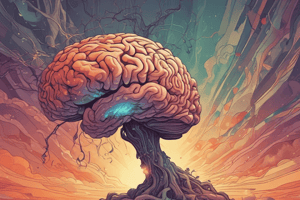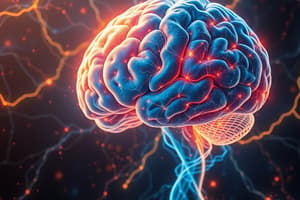Podcast
Questions and Answers
What is the primary advantage of using MEG over EEG?
What is the primary advantage of using MEG over EEG?
- It records data from individual neurons.
- It measures magnetic signals not affected by the skull/scalp. (correct)
- It generates faster results than EEG.
- It requires surgical intervention.
Which method directly measures changes in blood flow to assess brain activity?
Which method directly measures changes in blood flow to assess brain activity?
- EEG
- TMS
- Single neurone recordings
- fMRI (correct)
What was Karl Lashley's conclusion regarding brain lesions and complex behavior?
What was Karl Lashley's conclusion regarding brain lesions and complex behavior?
- The location of the lesion is critical.
- Lesions have no effect on complex behavior.
- Both the size and location of the lesion are equally important.
- The size of the lesion is critical. (correct)
What specific language ability was affected in Broca's patient?
What specific language ability was affected in Broca's patient?
What characteristic makes single neuron recordings particularly invasive?
What characteristic makes single neuron recordings particularly invasive?
Why is it important to use multiple techniques in cognitive neuroscience?
Why is it important to use multiple techniques in cognitive neuroscience?
What did Phineas Gage's accident reveal about the brain's role in behavior?
What did Phineas Gage's accident reveal about the brain's role in behavior?
Which technique is characterized by providing electrical signals to disrupt brain processing?
Which technique is characterized by providing electrical signals to disrupt brain processing?
What did Cajal propose about neurons?
What did Cajal propose about neurons?
According to Brodmann's findings, what can be concluded about neuron organization in different brain areas?
According to Brodmann's findings, what can be concluded about neuron organization in different brain areas?
How are action potentials from individual neurons used in single neurone recordings?
How are action potentials from individual neurons used in single neurone recordings?
What condition results from damage to regions in the temporal lobe?
What condition results from damage to regions in the temporal lobe?
What is a drawback of EEG compared to other brain imaging methods?
What is a drawback of EEG compared to other brain imaging methods?
What do contour maps used in EEG indicate?
What do contour maps used in EEG indicate?
What is the primary focus of modern neuroscience in terms of behavior?
What is the primary focus of modern neuroscience in terms of behavior?
What important discovery improved understanding of the brain's structure?
What important discovery improved understanding of the brain's structure?
What did Descartes associate with the pineal gland?
What did Descartes associate with the pineal gland?
What significant finding was observed in the study of epilepsy patients?
What significant finding was observed in the study of epilepsy patients?
Which concept was proposed by Franz Gall regarding brain function?
Which concept was proposed by Franz Gall regarding brain function?
What was one of the major criticisms of dualism as presented in the content?
What was one of the major criticisms of dualism as presented in the content?
What did Pierre Flourens argue against in his research?
What did Pierre Flourens argue against in his research?
What is the primary role of the lateral ventricle according to Descartes?
What is the primary role of the lateral ventricle according to Descartes?
What analogy did Descartes use to describe the function of the brain?
What analogy did Descartes use to describe the function of the brain?
What did Thomas Willis contribute to neuroscience?
What did Thomas Willis contribute to neuroscience?
Flashcards
Localization of Function
Localization of Function
The principle that specific areas of the brain are responsible for particular functions. For example, damage to Broca's area in the left frontal lobe can lead to difficulty producing speech.
Prosopagnosia
Prosopagnosia
A condition caused by damage to the temporal lobe, resulting in an inability to recognize faces, while still being able to recognize objects.
Neuron Doctrine
Neuron Doctrine
The theory that neurons are distinct cells that communicate with each other through synapses.
Broca's Area
Broca's Area
A region in the left frontal lobe of the brain responsible for speech production.
Signup and view all the flashcards
Wernicke's Area
Wernicke's Area
A region in the left temporal lobe of the brain responsible for language comprehension.
Signup and view all the flashcards
Brain Lesion
Brain Lesion
A procedure that involves damaging a specific area of the brain to observe its effects on behavior.
Signup and view all the flashcards
Lashley's Principle
Lashley's Principle
The observation that the size of a brain lesion, rather than its location, is more critical in affecting complex behavior.
Signup and view all the flashcards
Synapses
Synapses
The gaps between neurons where communication takes place.
Signup and view all the flashcards
Dualism
Dualism
The idea that the mind and brain are separate entities.
Signup and view all the flashcards
Pineal Gland in Dualism
Pineal Gland in Dualism
Descartes believed that the pineal gland was the point where information passed from the brain to the mind.
Signup and view all the flashcards
Brain as a Machine
Brain as a Machine
Descartes thought that the brain controlled the body like a machine, while the mind was responsible for higher functions like intellect and emotion.
Signup and view all the flashcards
Equipotentiality
Equipotentiality
The theory that all parts of the brain are equally capable of supporting mental functions.
Signup and view all the flashcards
Phrenology
Phrenology
Gall's theory that bumps on the skull could be measured to reveal the size of underlying brain regions and therefore a person's mental abilities.
Signup and view all the flashcards
Pierre Flourens and Equipotentiality
Pierre Flourens and Equipotentiality
Flourens rejected the idea that the brain had specific areas for different functions, arguing that the entire brain works together as a whole.
Signup and view all the flashcards
Epilepsy and Brain Localization
Epilepsy and Brain Localization
Experiments showing that seizures affecting one side of the brain caused movement on the opposite side of the body supported the idea of brain localization.
Signup and view all the flashcards
Single Neuron Recording
Single Neuron Recording
A technique used to measure electrical signals from individual neurons. It involves placing an electrode near a neuron and recording the action potentials produced by the neuron.
Signup and view all the flashcards
Electroencephalography (EEG)
Electroencephalography (EEG)
A non-invasive technique that measures electrical activity in the brain by placing electrodes on the scalp.
Signup and view all the flashcards
Magnetoencephalography (MEG)
Magnetoencephalography (MEG)
A non-invasive technique that measures magnetic fields produced by electrical activity in the brain.
Signup and view all the flashcards
Functional Magnetic Resonance Imaging (fMRI)
Functional Magnetic Resonance Imaging (fMRI)
A neuroimaging technique that measures blood flow in the brain. It is based on the principle that increased neural activity leads to increased blood flow.
Signup and view all the flashcards
Transcranial Magnetic Stimulation (TMS)
Transcranial Magnetic Stimulation (TMS)
A non-invasive technique that uses magnetic pulses to stimulate or inhibit brain activity. It can be used to study the function of different brain regions.
Signup and view all the flashcards
Spatial Resolution
Spatial Resolution
The ability of a neuroimaging technique to identify the precise location of brain activity.
Signup and view all the flashcards
Temporal Resolution
Temporal Resolution
The ability of a neuroimaging technique to detect the timing of brain activity.
Signup and view all the flashcards
Multimodal Neuroimaging
Multimodal Neuroimaging
The use of multiple neuroimaging techniques to study brain activity. Each technique has its own advantages and disadvantages.
Signup and view all the flashcardsStudy Notes
Brain and Behaviour - Lecture 1
- Mind-Brain Link: The lecture examines the relationship between the mind and brain.
- Immaterial Soul: A concept of the soul that exists separate from the physical body.
- Dualism: The philosophy that mind and body are separate entities.
- Materialism: The idea that the mind is a product of the physical brain.
- Brain Structure and Function: Examines how different brain structures relate to specific functions.
- Localized: Specific functions are localized to specific brain areas.
- Distributed: Brain functions are distributed across many areas.
- Cognitive Neuroscience Techniques:
- Single Neuron Recording: Measures activity of individual neurons.
- EEG (Electroencephalography): Measures electrical activity in the brain.
- MEG (Magnetoencephalography): Measures magnetic fields generated by brain activity.
- PET (Positron Emission Tomography): Measures blood flow in the brain.
- fMRI (Functional Magnetic Resonance Imaging): Measures brain activity by detecting changes in blood flow.
- TMS (Transcranial Magnetic Stimulation): Disrupts brain activity in a targeted area.
Ancient Egyptian Beliefs
- Brain Disregard: Egyptians removed and discarded the brain during mummification, believing the heart held the essence of life.
- Heart's Importance: The heart was considered crucial to behavior and life.
Plato and Aristotle's Perspectives on the Soul
- Early Attempts at Separation: Philosophers attempted to distinguish the mind and soul from the body.
- Aristotle's Heart Theory: Aristotle believed the mind resided in the heart. Damage to the heart resulted in death immediately.
- Mind Divisions (Aristotle): Aristotle identified three main divisions of the mind: imagination, reasoning, and memory.
- Brain's Role (Aristotle): Cooling the blood was the brain's function.
- Plato's Tripartite Soul: Plato proposed the mind/soul had three components: reason, emotion, and desire.
- Psyche (Greek): The goddess of the mind, from which the term "psychology" originates.
Hippocrates and Galen
- The Brain as the Center: Hippocrates theorized that the brain controlled emotions, sensations ("joy, etc.") and brain behavior
- Brain Injuries and Convulsions: Localized brain injuries could lead to convulsions on the opposite side of the body.
Renaissance and Dualism
- Leonardo and Michelangelo: Their artistic renditions of the brain were influenced by Galen's theories.
- Descartes and Dualism: Descartes viewed the mind and the brain as separate entities with the pineal gland as the connection point.
Localization of Function
- Gall's Phrenology: Gall proposed that specific mental functions were localized to areas of the brain. Brain size and skull bumps were correlated to behavior by observing the size of bumps on the skull.
- Equipotentiality Hypothesis: Others opposed this notion. Flourens thought the brain functions as a whole, rather than specializing specific regions.
- Lashley's Experiments: Discovered that the complete removal or damage to specific sections of the brain is not as important as the size of the damage to various regions.
- Broca's and Wernicke's studies: Detailed studies on patients with language impairments pinpointing locations in the frontal and temporal lobes of language function respectively
- Phineas Gage: An accident to frontal lobe resulted in dramatic personality changes illustrating that behavior is complex and different areas are important.
Modern Understanding and Techniques in Neuroscience
- Single Neuron Recordings: Analyze the activity of individual neurons.
- EEG and MEG: Monitor brain activity using electrical and magnetic signals.
- fMRI: Observe brain activity by detecting blood flow changes.
- TMS: Affect specific brain regions using magnetic pulses.
Studying That Suits You
Use AI to generate personalized quizzes and flashcards to suit your learning preferences.




